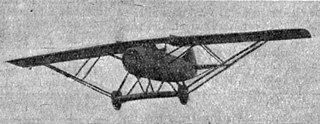
The LFG Roland C.II, usually known as the Walfisch (Whale), was an advanced German reconnaissance aircraft of World War I. It was manufactured by Luft-Fahrzeug-Gesellschaft G.m.b.H.

The Roland D.VI was a German fighter aircraft built at the end of World War I. It lost a fly-off to the Fokker D.VII, but production went ahead anyway as insurance against problems with the Fokker.

The LFG Roland D.III was a fighter aircraft produced in Germany during World War I.
The Junkers J 15 was an all-metal monoplane built in Germany in 1920 to explore the design parameters of small single-engined passenger transports. In particular, it could fly in either high or low wing configurations. It led to the Junkers J 16 light airliner.

The Kondor D 7 was a prototype German single seat biplane fighter built over the winter of 1917-18. It was not a success and its development was soon abandoned.

The Letov Š-3 was a single-seat, single-engine parasol wing fighter aircraft designed and built in Czechoslovakia in the early 1920s. Only one was completed and flown, its makers preferring to develop a biplane fighter.
The Dewoitine D.15 was a single-engine, single-seat biplane fighter aircraft built in France in the 1920s. Intended to offer structural simplifications when compared with monoplanes, it had a disappointing performance and was soon abandoned.

The Hanriot HD.15 was a French two seat fighter aircraft fitted with a supercharger for good high altitude performance, built in the 1920s. Three were ordered by Japan but lost at sea during delivery.

The Luft-Fahrzeug-Gesellschaft (LFG) Roland D.VII was a German single seat, single engine biplane fighter aircraft built during World War I. Problems with its underdeveloped V-8 engine prevented its production.

The LFG Roland D.IX was a World War I German single seat fighter aircraft, a biplane powered by one of a new generation of powerful rotary engines. Three slightly different prototypes were built but there was no series production.

The LFG Roland D.XV was a World War I German single seat fighter aircraft, ordered as a test-bed for engine comparisons. It was distinguished from earlier Roland biplane designs by the elimination of flying wires. Two later aircraft, also called LFG Roland D.XV, were completely different designs with slab sided fuselages.

The LFG Roland D.XVI, initially designated the LFG Roland E.I, was a single-seat, single-engine, parasol wing German fighter aircraft flown close to the end of World War I. Only two were built.

The LFG Roland D.XVII was a single-seat, single-engine, parasol wing German fighter aircraft flown close to the end of World War I. Only one was built.

The LFG Roland Pfeilflieger, (Arrow-flyer), was a German swept wing, single engine, two seat biplane built in Germany in 1914. It made one distinguished long duration flight and served in colonial German South-West Africa.
The Schütte-Lanz D.VI was a single engine, parasol wing fighter aircraft designed and built in Germany towards the end of World War I. It had a very short career, crashing on its first flight.
The Schütte-Lanz D.VII was a single engine, biplane fighter aircraft designed and built in Germany towards the end of World War I.

The Salmson-Béchereau SB-5 was a two-seat fighter aircraft built for a French government programme in 1925. Despite a powerful engine it did not perform well and only one was built.

The LFG V 3 Susanna was a three seat, high wing monoplane flying boat with a single, pusher configuration engine mounted above the wing. A later variant, the LFG V 3a Susanne, was a bigger, more powerful four-seater. Only one of each was built.
The LFG V 8 Bärbel (Barbel) in English) was a small, single-engined, biplane flying boat which carried two passengers. The sole example was built in Germany shortly after World War I but was exported and used for Baltic flights.
The LFV V 18 Sassnitz was a German flying boat able to hold up to eight passengers. Only one is known to have flown.














